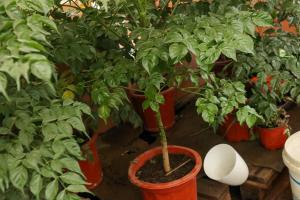Introduction
Tomato plants are susceptible to various diseases and environmental factors that can cause the leaves to turn black. It can be a troubling issue for many gardeners as it affects the health and productivity of the plants. In this article, we will discuss the common causes of blackening of tomato plant leaves and ways to prevent and mitigate the damage.
Causes of Blackening of Tomato Plant Leaves
There are several reasons why tomato plant leaves turn black, and some of the common causes are:
Bacterial Infections
One of the most common reasons for tomato plant leaves turning black is bacterial infections. Bacterial infections like bacterial speck, bacterial spot, and bacterial canker can damage the leaves and cause them to turn black. These infections can spread rapidly and affect the entire plant's health, causing reduced yield and even plant death.
Fungal Diseases
Fungal diseases like early and late blight can also cause black spots on tomato plant leaves, stems, and fruit. These infections can quickly spread and cause severe damage to the plants, causing the leaves to wilt and turn black.
Viral Diseases
Tomato plants infected with viral diseases can show black spots on their leaves, which is often an early sign of the disease. Viral infections can cause stunted growth and severely affect the plants' health and productivity.
Environmental Factors
Environmental factors like excessive heat or cold can also cause tomato plant leaves to turn black. When the temperature is too high, the leaves tend to wilt, dry out, and eventually turn black. On the other hand, when the temperature is too low, the leaves can develop black spots due to frost damage.
Prevention and Mitigation of Tomato Plant Leaves Turning Black
To prevent or mitigate the damage caused by blackening of tomato plant leaves, gardeners can take the following steps:
Practice Good Sanitation
Practicing good sanitation can prevent the spread of bacterial, fungal, and viral infections. Gardeners should remove the infected plant parts as soon as possible and dispose of them correctly.
Choose Resistant Varieties
Choosing resistant varieties of tomato plants can help ensure that the plants are less susceptible to diseases and environmental factors that cause blackening of leaves.
Proper Watering Techniques
Proper watering techniques, such as watering at the base of the plant and avoiding overhead watering, can help prevent the spread of bacterial and fungal infections.
Use Organic Fertilizers
Using organic fertilizers instead of chemical fertilizers can help improve the soil's health and prevent the spread of diseases and environmental factors that cause blackening of tomato plant leaves.
Provide Adequate Lighting and Temperature Control
Providing adequate lighting and temperature control can help prevent the damage caused by environmental factors. Gardeners can use shade cloth or windbreaks to protect the plants from excessive heat or cold, respectively.
Conclusion
Tomato plant leaves turning black can be a frustrating issue for gardeners. However, by understanding the various causes and taking the necessary preventive measures, gardeners can ensure the health and productivity of their tomato plants. Practicing good sanitation, choosing resistant varieties, proper watering techniques, using organic fertilizers, and providing adequate lighting and temperature control are some of the essential steps that gardeners can take to prevent or mitigate the damage caused by blackening of tomato plant leaves.

 how many times do yo...
how many times do yo... how many planted tre...
how many planted tre... how many pine trees ...
how many pine trees ... how many pecan trees...
how many pecan trees... how many plants comp...
how many plants comp... how many plants can ...
how many plants can ... how many plants and ...
how many plants and ... how many pepper plan...
how many pepper plan...































